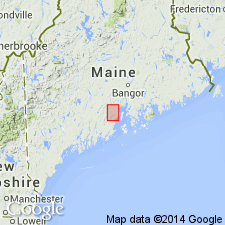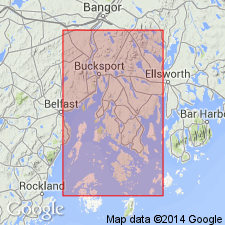
- Usage in publication:
-
- Appleton Ridge Formation
- Modifications:
-
- Named
- Dominant lithology:
-
- Schist
- Phyllite
- AAPG geologic province:
-
- New England province
Summary:
Named for Appleton Ridge in Knox and Waldo Cos, ME. Previously called Appleton formation (informal) by Cheney (1967). Consists of lower andalusite zone (staurolite schist), garnet zone (phyllite with minor garnet), and the Muzzy Ridge Member (cummingtonite-garnet schist). Bedded and sheared. 1,200 m thick. Conformably overlies Bucksport Formation; in fault contact with Jam Brook Formation to the southwest and Penobscot Formation to the northeast along St. George fault. Age is Early Devonian.
Source: GNU records (USGS DDS-6; Reston GNULEX).

- Usage in publication:
-
- Appleton Ridge Formation*
- Modifications:
-
- Age modified
- AAPG geologic province:
-
- New England province
Summary:
The age of the Appleton Ridge Formation (Bickel, 1976) is changed to Silurian(?) based on its intertonguing relationship with Bucksport Formation of Trefethen (1950) and Wing (1957). Bucksport correlates along strike with Flume Ridge Formation dated as Silurian by West and others (1992).
Source: GNU records (USGS DDS-6; Reston GNULEX).
For more information, please contact Nancy Stamm, Geologic Names Committee Secretary.
Asterisk (*) indicates published by U.S. Geological Survey authors.
"No current usage" (†) implies that a name has been abandoned or has fallen into disuse. Former usage and, if known, replacement name given in parentheses ( ).
Slash (/) indicates name conflicts with nomenclatural guidelines (CSN, 1933; ACSN, 1961, 1970; NACSN, 1983, 2005, 2021). May be explained within brackets ([ ]).

